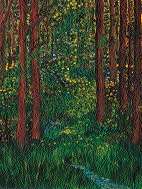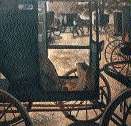 |
Retaining Intensity As by Winsor Newton | 
|
| A general statement the more colours in a mixture, the nearer to black (muddiness) the mixture will become. When mixing you cannot obtain a colour of greater intensity by using a mixture of others. For example, no colour can be added to a mixture of Davy�s Gray and Cadmium Lemon to regain the intensity of Cadmium Lemon alone. |
|
| Tinting Strength Every pigment varies in strength. Winsor Blue, for example, has a high tinting strength whilst Terre Verte has a low tinting strength. In other words Winsor Blue will have a dominant effect on any mixtures whilst Terre Verte will not have a significant effect in mixtures. Care is required in colour mixing to avoid the strong colours over-dominating the paint surface. Strong colours can be controlled by adding small amounts to the mixture repeatedly until the required hue is reached. Alternatively, some artists may choose colours with lower tinting strength, for example, Ultramarine (Green Shade) in preference to Winsor Blue (Green Shade) as it has a lower tinting strength. |
|
High tinting strength colours are often high key whilst low tinting strength colours are often low key. As a general guide the following colours tend to have a high tinting strength, relative to other colours of similar hue:
Benzimidazolones;
Cadmium Yellows, Oranges & Reds; Winsor (Phthalo) colours; colours pre-fixed with �Permanent�
eg. Permanent Alizarin Crimson; Perylenes; Quinacridone colours; Prussian Blue; Mars
colours; Burnt Sienna; Lamp Black and Titanium White.
NB. Artists� quality colours generally have higher tinting strength than the equivalent colour in the more moderately priced second quality ranges. Although this does of course have an effect on colour mixing, providing stronger mixtures, it should not be confused with the relative strength of each pigment. For example, Prussian Blue has a high tinting strength in all ranges.
Value and chroma - 'high key and low key colour' Each pigment has a relative ability to reflect or absorb light (value) and each colour has a relative intensity
(chroma). Those which reflect a greater quantity of light or have a high intensity
make �high key� colours, for example Cadmium Yellow. Those which absorb less light or have a low intensity make �low key�
colours, for example Yellow Ochre.
Although many artists will balance high and low key colour across their paintings, successful works can exploit high key or low key colour throughout.
high key painting
low key painting


Alan Foster
Wendell Upchurch